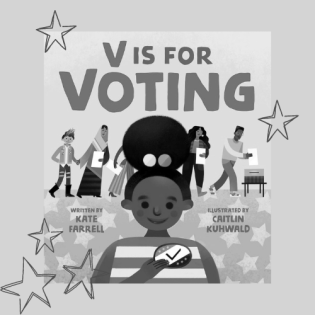V Is for Voting Literature Guide
In this book, author Kate Farrell and illustrator Caitlin Kuhwald take readers on a rhyming journey through the importance of voting to all members of society. The alphabet book highlights important people and actions in US history related to personal action for the good of all.
Before Reading
Ask: Voting in an election is a process adults have the right and responsibility to do. Talk about rights and responsibilities.
Show: Look at the cover showing people voting. What do you know about voting and elections? Share stories of going to the polls.
Connect: What are some ways you vote in your daily life? A group might raise their hands to show their opinions, or you might speak up about your choices at home. Compare this to the election process.
During Reading
Ask: What does active participation mean? What things do you actively participate in? School? Games? How do you think people can actively participate in choosing leaders and laws for our communities?
Show: Notice the pictures of people of all colors, ages, sizes, and genders. Talk about why differences make us stronger together.
Connect: Learn about the history of voting rights on the final page of the book.
After Reading
Ask: What do you think young people can do if they aren't old enough to vote?
Show: Look at the picture on the letter S page and learn about the people who fought for the right to vote.
Connect: Many people still have a hard time getting to the polls because they don't have an ID or a car, or they have a barrier that is hard to get through. What do you think we can do to help?
Activities
- Make signs and posters that encourage people to vote. Write a poem that expresses your opinion about using your voice for a better world. Display them where you can get permission.
- Draw a picture of a person who fought for voting rights and write facts about them.
- Share with your family members what you have learned about the voting process. Ask them what they think about voting.
- If your school closes on Election Day to become a polling place, ask what kids can do in advance to welcome people to the building and make the place look good and feel comfortable for voters.
- Interview a person who volunteers at a polling place. Ask what people can learn from people who volunteer at the polls.
Reflection
- What are your thoughts about the voting process?
- Why do you think it is important for every citizen to vote on important issues?
- Out of all of the letters of the alphabet in this book, what were your top five favorites? Why?
- What will you say to family or friends who think it doesn't matter whether or not they vote?
